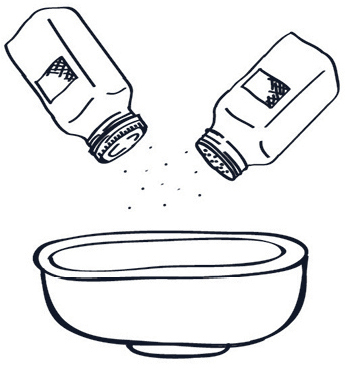PANTRY AND COOKING BASICS
The recipes you will find in this book are very approachable for a home cook because the home kitchen is where they originated. The key to all these recipes is quality ingredients, so we suggest, when possible, using locally grown produce and dairy from your farmer’s market.
One item we use exclusively from the farmer’s market is eggs. They’re always best from free-range chickens and you’ll find that the more diverse the hen’s diet is, the more beautiful the yolks will be to see and to taste.
Overall, the grain of kosher salt is most suitable for cooking, as it allows you to control the level of salinity in a dish. Kosher salt is commonly found in grocery stores.
There are a few products called for in this book that may require a specialty store:

ORANGE BLOSSOM WATER AND ROSE WATER.
These Middle Eastern staples are generally sold in the international section of many grocery stores, but if you are having trouble finding them, you can easily order them online.

LEBANESE YOGURT OR LABNEH.
This “yogurt” is actually a very thick and tart soft cheese. Again, it may only be available in specialty shops. A useful substitution in this case would be whole-milk Greek yogurt.

FRESH HERBS.
We love cooking with fresh herbs, as you will see throughout this book. Though you can easily find them in supermarkets, if you live in a space that allows you to grow herbs, there is nothing as satisfying as going out into your own garden and clipping them straight from the plant!

ZA’ATAR.
This all-purpose spice blend is used in many different kinds of Middle Eastern cooking. It’s sprinkled onto breads, generously added to finish hummus, and liberally added to vegetables or fish. It’s usually available in specialty shops or online as a premixed seasoning, but can easily be made at home. Simply combine equal parts white sesame seeds, dried thyme, dried oregano, and sumac.
There are a couple of tools that are essential in our kitchen and come in handy when cooking the recipes in this book:

MICROPLANE.
This versatile tool, primarily intended for zesting citrus, is also perfect for grating nutmeg, finely shaving a clove of garlic, or creating a pillowy blanket of Parmesan.

JAPANESE MANDOLINE.
This is an inexpensive alternative to its bulky French cousin. Always pay close attention while using a mandoline, as it can be deceptively sharp. The Japanese mandoline is plastic but still heavy-duty. Use it to grate beets for a grain bowl, shred carrots, and create thin slices of radish for garnishing.
Finally, here are a handful of recipes that we use in the restaurant for a wide variety of dishes and accompaniments. You may find them so delicious and popular that you’ll want to keep a batch on hand for whenever the impulse strikes.
GARLIC BUTTER

Yields roughly ½ cup
6 garlic cloves
1 tablespoon packed flat-leaf parsley leaves
Pinch of kosher salt
8 tablespoons (1 stick) unsalted butter, at room temperature
Mince the garlic and finely chop the parsley leaves. Mix the garlic, parsley, and salt into the butter until very well combined. This will keep, refrigerated, for up to 2 weeks.
HOMEMADE MAYONNAISE
Yields roughly ½ cup
This flavorsome, versatile recipe can be used in any dish that calls for the store-bought equivalent.

1 small garlic clove
1 egg yolk
2 teaspoons fresh lemon juice
½ teaspoon Dijon mustard
¼ cup sunflower seed oil
¼ cup olive oil
Kosher salt
Finely grate the garlic clove with a Microplane into a small bowl with the egg yolk, lemon juice, and mustard. Whisk until fully combined.
Combine the sunflower seed and olive oils in a spouted measuring cup. In a very slow and steady stream, while whisking continuously, add the oils to the yolk mixture. The mixture will emulsify and become quite thick. Season with salt.
HOT SAUCE
Yields 1 cup
Maya and Dean both grew up being served spicy condiments (harissa in Israel and peri peri in South Africa, respectively) alongside the home-cooked meals from their grandmothers’ kitchens. At Jack’s Wife Freda we love the option of adding a spicy kick to any of our dishes. Our hot sauce goes with almost every item on our menu: from the steak and eggs at breakfast to the peri peri chicken at dinner. Many of our guests insist on dipping their French fries in it too. Don’t be shy!

1 jalapeño chili
1 serrano chili
Optional: 1 habanero chili for extra heat
3 garlic cloves
2 bunches of cilantro, stems removed
¼ cup sunflower seed oil
Kosher salt
Slice the jalapeño and serrano chilies into ¼- or ½-inch rings, including the seeds. (For an extra-spicy hot sauce slice and add the habanero.)
Put the chilies into a blender with the garlic cloves and cilantro.
Add ¼ cup water and the oil and blend on high speed for 1 to 2 minutes, or until the mixture is smooth and consistent. Season with salt and additional water if the mixture is too thick.
PERI PERI SPICE

Yields ¾ cup
Nothing brings Dean back to his childhood in Johannesburg quite like the flavor of peri peri spice. The bird’s-eye chili, though native to South America, was spread around the globe as a result of Spanish and Portuguese colonization. As these flavors trickled over the border from Mozambique, they wove their way into regional South African cuisine where they can be found today in virtually every kitchen, restaurant, and street cart. At Jack’s Wife Freda, you can find our own spicy, smoky, slightly sweet version in our signature peri peri chicken dish, as a dry rub on our chicken kebabs, and as a gravy for our sweetbreads. Since it is difficult to find the African bird’s-eye chili, we use the more commonly available árbol chili.
1 tablespoon ground árbol chili
5 tablespoons Hungarian paprika
3 tablespoons light brown sugar
1 tablespoon kosher salt
1 teaspoon ground cumin
½ teaspoon ground allspice
Pinch of ground cloves
Combine all the ingredients in a small bowl, mixing well so that the brown sugar is evenly distributed.
SALSA VERDE

Yields roughly 1 cup
This is an all-purpose sauce that can finish many dishes with a savory acidity. We serve it with poached eggs, chicken kebabs, and fish for a flavorful, tangy kick. It will last for 2 days, refrigerated, but is sure to vanish quickly once you’ve tried it.
1 cup packed flat-leaf parsley leaves
1 shallot
1 garlic clove
Zest of 1 lemon
1 tablespoon sherry vinegar
1 cup olive oil
Kosher salt
Chop the parsley very finely and transfer to a small bowl.
Finely mince the shallot and garlic, then add to the parsley.
Add the lemon zest to the parsley with the sherry vinegar.
Mix well by hand while slowly adding the olive oil.
Season with salt.
SMOKED PAPRIKA AIOLI

Yields roughly ½ cup
1 cup mayonnaise (for homemade, see here)
2 teaspoons smoked paprika
Zest of ½ lemon
In a large bowl, mix all the ingredients together. Use a rubber spatula to remove any lumps of paprika, stirring until uniform in color.
TZATZIKI

Yields 1½ cups
This classic Greek recipe is a condiment for some, a dip for others, and a favorite accompaniment for many dishes in Israel. We use a Lebanese yogurt called labneh to give the tzatziki its thicker consistency and tangier taste, but you can absolutely substitute strained Greek yogurt.
½ English (hothouse) cucumber
1 garlic clove
2 tablespoons fresh dill, stems removed
1 cup labneh or Greek yogurt
1 teaspoon red wine vinegar
1 teaspoon fresh lemon juice
1 tablespoon olive oil

Kosher salt
Using the largest holes on a box grater, shred the cucumber (including its skin).
Finely grate the garlic with a Microplane and coarsely chop the dill tops.
In a small bowl, combine the yogurt, shredded cucumber, garlic, red wine vinegar, lemon juice, olive oil, and dill. Stir to combine. Season with salt.



